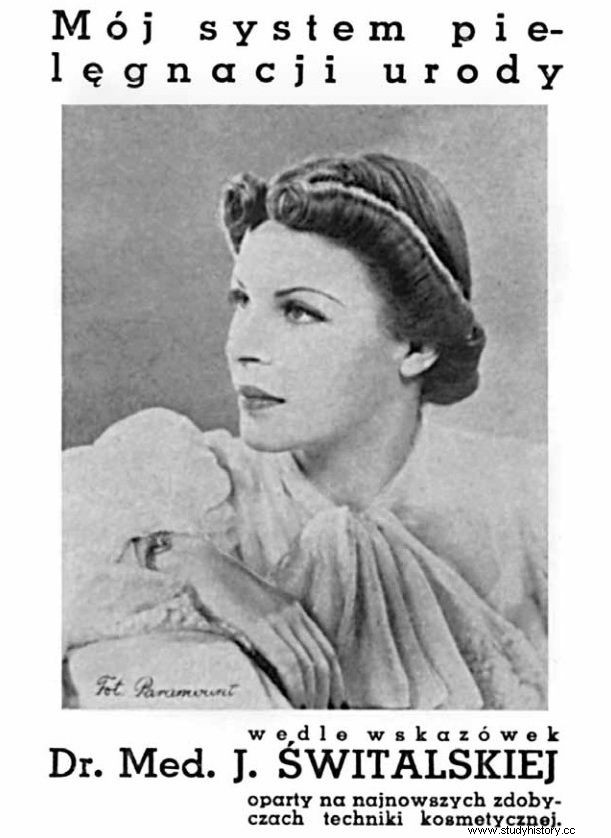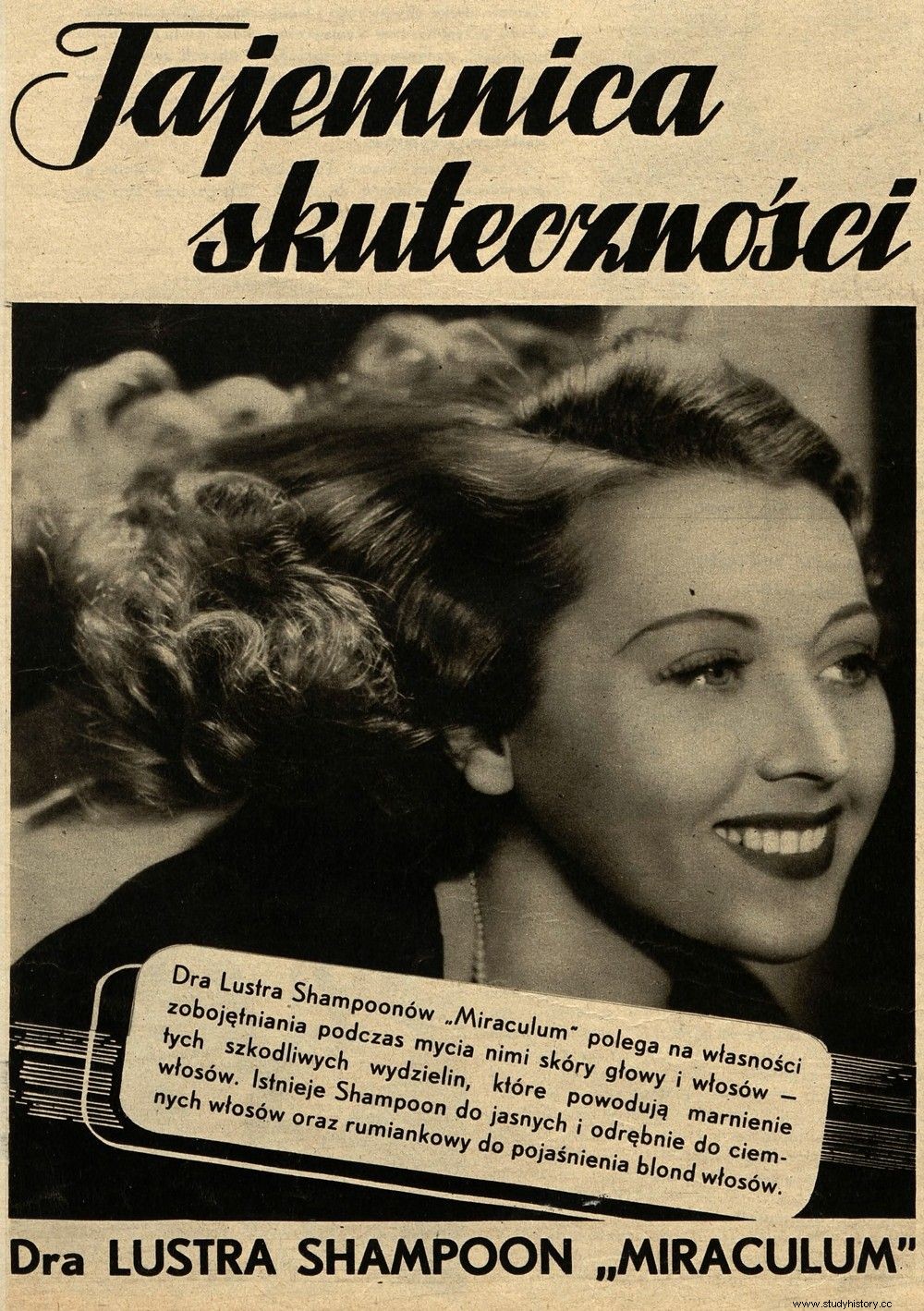Creams, lipsticks, reliable advice. In pre-war Poland, beauty was a necessity. And there were also bright businesswomen who could make millions on it!
In 1938, Jan Wiktor, one of the newspaper's columnists, summed up the state of the Polish perfumery and cosmetics industry in the women's magazine “Świat Piękna Pani”. His data is definitely worth recalling.
A year before the outbreak of World War II, there were over 250 production facilities on the Vistula which produced 3,000,000 kilograms of cosmetics, toilet soaps and perfumes during the year ! Bagatela 100,000 commercial enterprises, beauty salons and hairdressers distributed these products and used them in their daily practice.
In the same newspaper, Helena Brzezińska emphasized the good quality of domestic plants:
In Poland, we already have a lot of first-class cosmetic laboratories and factories, which can make it easier for every woman to fulfill her daily duties in relation to the needs of health, skin and beauty.

Nothing ruins makeup like badly painted lips. In the 1930s, an untrained hand could be supported with a special template. Such a template allowed to obtain the desired shape thanks to two strokes of the lipstick. The photo and caption are from our newest book, Beauty Without Preservatives.
Phials of the Egyptian Goddess
Who, how who, but Brzezińska knew exactly what she was talking about. After all, she was one of the precursors of cosmetics in the country. Her Izis Medical Cosmetics Institute, which was located in Warsaw, in addition to the use of typical care treatments, also produced care preparations. Brzezińska herself had a thorough cosmetic education, first in Poland and then in Paris. Anyway, Helena Rubinstein, born in Krakow, was also educated on the Seine, and then successfully conquered world markets.
With a diploma in her pocket, Helena Brzezińska opened her Institute in 1927. At Żabia Street in Warsaw, at number four, there was a cosmetic laboratory, producing mainly creams, which were later sold in salons. The newspapers were full of Izis ads, emphasizing that the whole thing was in charge of a dermatologist, and the head of the company herself gave a lot of beauty advice in various press titles.
While working on my previous publication, "Occupation from the Kitchen", I ran into a very peculiar advertisement in one of the old cookbooks. It showed an Egyptian goddess holding a bottle. A black slave huddled at her feet. Against the background of a gloomy black and white brochure, the full-page, multi-colored advertisement was like a bird of paradise.
Helena Brzezińska and S-ka invited you to treatments, advice, tips and the purchase of cosmetics. As you can see, the company functioned at its best during the occupation. And ... still works. It runs medical, cosmetic and hairdressing salons in Warsaw, a cosmetics and household chemicals laboratory, and produces cosmetics. Driven by curiosity, I decided to check if the employees of contemporary Izis stores know anything about the origins of this well-deserved brand.


The Izis Medical Cosmetics Institute did not stop advertising itself even during the occupation (source:public domain).
When I called one of the institutions, a nice lady answered. I immediately explained to her that I was not calling to make an appointment, but for a slightly different matter. When asked if she knew anything about the company's origins, she initially said no.
This unusual phone call must have caught her off guard, because after hesitating for a few seconds, she began to say that Izis probably had a pre-war pedigree. Unfortunately, my interlocutor could not tell me anything more ... It's a pity. After all, Kosmetyczno-Lekarska Spółdzielnia Pracy Izis (the company operates under this name today) should definitely be proud of its traditions! Has what.
Sunrise in cosmetology
A year after Helena Brzezińska, Dr. Julia Świtalska founded her Hygienic Cosmetics Laboratory Świt. In the matter of beauty care, the doctor was an undeniable expert. It was hard not to come across her advice in women's newspapers, and the huge number of guides she published at the time led the then elegant ladies through the meanders of rational cosmetics. So that they can take care of themselves from the top of the head to the smallest toes.
From 1934, her entire cosmetic activity was concentrated in Warsaw, at Aleja Ujazdowskie at number 37, in a magnificent, over twenty-room apartment. Świtalska decided that only Polish ingredients will be used for production in her laboratory.
Jan Wiktor emphasized in his article that the doctor declared a fight against importing foreign cosmetics and foreign raw materials to Poland. Perhaps it was related to the quite… xenophobic approach of Świtalska to various issues.

In pre-war Poland, Julia Świtalska was a real man-institution, and her cosmetics company was a real empire. The photo shows the employees of the Laboratory of Hygienic Cosmetics "Świt", headed by the boss (in the middle, marked with a cross), Warsaw, 1939. The photo and caption are from our newest book, Beauty Without Preservatives.
The bias of a beauty expert is easy to spot in her books. In one of them, the doctor even allowed herself to make a racist comment that - as she noted - Negroes stink exceptionally. Whatever her views may be, her contribution to Polish cosmetology should be appreciated.
The Świt Laboratory consisted of many departments, including technical, cosmetic, publishing and, finally, medical departments, which Świtalska ran personally. There was also a training department dealing with running four-month vocational courses. As Jan Wiktor wrote in 1938, the production included:
1) a range of skin care products, 2) body care cosmetics, 3) hair care products, 4) defect remedies, 5) beauty products, 6 ) intimate means. More than one hundred preparations make it possible to use them individually, even for people with the most complex complexion.
Among all these cosmetics were the latest achievements of contemporary medicine. Customers who dreamed of preserving youth could, for example, reach for a hemoglobin mask that was supposed to nourish and regenerate the skin. Animal rights organizations would have much to protest over this "miracle measure". The masks were made from the blood of young animals.
If you think that such vampire methods have no place in the world of modern, modern science, you better read the offer of aesthetic medicine clinics. Foreign stars have recently popularized a bloody rejuvenating treatment. Fortunately, the vampire facelift no longer sucks the spirit of innocent animals into the race for beauty. Blood is drawn from the patient himself, whose face is then injected with his own plasma.

From a legionary doctor practicing in military hospitals during the First World War to the national beauty guru? Julia Świtalska proved that such a career is possible. The illustration and caption are from our newest book, Beauty Without Preservatives.
If someone wanted to rejuvenate and regenerate the skin, he could also add a little… radiation glow. Świtalska in her office offered "preparations, compresses and radioactive baths, which include radium emanation, produced in a specially imported apparatus". The device contained a real radioactive substance. And actually, no wonder, because before the war, rad was considered a panacea for any ailment.
A wonderful reflection in the mirror ... of Dr. Mirror
Today, it seems quite obvious to us to divide cosmetics according to the type of skin for which they are intended. Meanwhile, in Poland such a distinction began to be used only in 1924, which was initiated by Dr. Leon Luster.

Polish cosmetics producers had to fight with foreign products primarily with the quality of their own products. The photo shows raw materials testing in the "Miraculum" laboratory. The photo and caption are from our newest book, Beauty Without Preservatives.
This cosmetologist, whose contribution to the development of the art of care on the Vistula River cannot be overestimated, was first educated at the Faculty of Medicine of the Jagiellonian University. Then he specialized in foreign institutions, including in Berlin, Hamburg and Vienna.
Luster and his wife lived in Krakow, and it was in this city that, together with engineer Witold Boehm and Henryk Pakszwer, on July 15, 1924, he registered the company of Doktor Lustra Cosmetic and Medical Preparations "MIRACULUM".
Initially, the factory located at Józefitów Street in Krakow was not very impressive. As Wojciech Baranowski writes in the article presenting the Mirror's biography, the situation changed after two years. Miraculum found a new seat at Sławkowska Street, occupying two floors of a tenement house. Leon Luster ran his practice on the ground floor. Moreover, employment in the company increased to 20 people. What did this development result from?
Dr. Luster's factory invested in advertising, but approached the issue in an innovative way. In addition to creating standard materials that appear in the press, stars were involved in the action. Cosmetics manufacturers aimed high at once, choosing prima sort ambassadors. The first one was Hanka Ordonówna herself. Why her? The choice was not that difficult at all.
This railwayman's daughter, Maria Anna Pietruszyńska (because that was her real name) was not the star of one hit or a supporting actress. She was considered a true artist, known for her silver screen, cabaret scenes and, above all, her immortal songs. A postcard by Zygmunt Garzyński with a portrait of Ordonka and a signature was enough: But of course the best cosmetics are Dr. Mirrors, and I personally only use these - they are just wonderful. Hanka Ordonówna for soaring sales.

The first ambassador of Dr. Lustra's cosmetics was Ordonka herself (source:public domain).
Miraculum was also involved in publishing activities. The company released works on cosmetology by Dr. Luster, engineer Witold Boehm, and Dr. Zbigniew Barski. An interesting theory about the last gentleman is presented by Wojciech Barański in his biographical text.
The brochure "How to rationally nurture your beauty" written by Barski is published in an elegant way, with a colorful cover, interesting illustrations inside and no less colorful advertisement at the end, encouraging you to choose one of the twelve Miraculum cosmetics. It was distributed among customers for free. The same author also published "Zarys kosmetyki lekycznej" in 1929. Barański writes:
There is an interesting fact about the book. Well, the footer states that this is the third edition of this book, although it was published only once - on the occasion of the General National Exhibition, which took place in Poznań in 1929.

Leon Luster spared no money on advertising. Here is an advertisement for a shampoo placed in one of the issues of the well-known "Światowid" (source:public domain).
A simple, though cynical procedure was to convince the readers that the previous editions, due to the popularity of the item, had long been exhausted. There is one more controversy connected with the figure of Dr. Zbigniew Barski. There are many indications that the cosmetologist with the given name ... did not exist at all. Behind the alleged Mr. Barski was Dr. Leon Luster himself. By taking a pseudonym, he wanted to give himself credibility in promoting his own products. Regardless of whether the item was written by Mirror or Barski, the book is really interesting.
Unfortunately, the specimen that I managed to hunt down in an antiquities shop is in terrible condition, its cover is torn, and half of the pages are flying loosely. On the title page it is clearly "wrote popularly and scientifically by Dr. Z. Barski ". The price crossed out below and information on what occasion the publication is distributed free of charge. Then there is just a lot of medical and cosmetic knowledge, Miraculum surreptitious advertising and the smell of books that are already reaching a hundred.
***
Dozens of reliable recipes. Affordable recipes. And this:a fascinating story about how Polish women cared for themselves in pre-war Poland. Buy your own copy of Aleksandra Zaprutko-Janicka's book “Beauty without preservatives. Beauty secrets of our great-grandmothers ”
